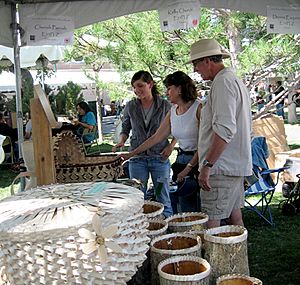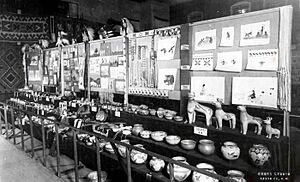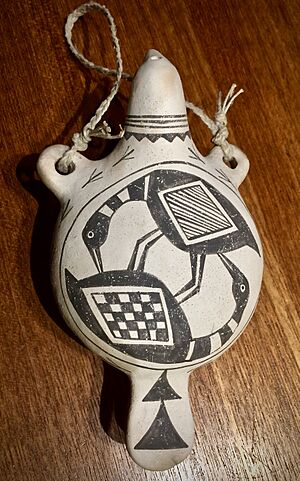Santa Fe Indian Market facts for kids

The Santa Fe Indian Market is a big art show held every year in Santa Fe, New Mexico. It happens on the weekend after the third Thursday in August. About 150,000 people from all over the world come to see it!
This special market is put on by the Southwestern Association for Indian Arts (SWAIA). SWAIA is a group that doesn't make money for itself; instead, it helps artists. The market shows amazing art by about 1,000 Native American and First Nations artists. These artists come from many different tribes and Indigenous groups across North America.
Contents
History of the Market
How the Market Started
The very first Indian Market was held in 1922. It was called the Southwest Indian Fair and Industrial Arts and Crafts Exhibition. This event was part of the Fiesta de Santa Fe and was supported by the Museum of New Mexico.
A person named Rose Dougan first thought of having a competition for Native American art. Edgar L. Hewett, who led the Museum of New Mexico, saw these early art fairs as a way to share knowledge about different cultures. The events took place inside the National Guard Armory, and people paid a small fee to get in.
At first, the market mainly showed Pueblo pottery, Navajo textiles, and Pueblo Flatstyle paintings. These paintings were often made by artists from places like the Santa Fe Indian School. Even so, the very first prize for the best tribal display went to beautiful beadwork from the Assiniboine and Sioux Tribes of the Fort Peck Indian Reservation in Montana.
Early on, museum staff and later Native artists themselves judged the artwork. They gave out prizes. The artists who made the pottery were not usually there to sell their work. These early markets aimed to make sure that the quality and true style of Pueblo pottery stayed high. Some people worried that tourists wanting souvenirs might make artists create lower-quality work.
Changes in the 1930s
In 1936, a group called the New Mexico Association on Indian Affairs took over the market. For a few years, from 1933 to 1936, the events were held in different Pueblo communities instead of in Santa Fe.
Maria Chabot helped bring the events back to Santa Fe. The New Mexico Association on Indian Affairs helped artists get to Santa Fe. They also put "labels of approval" on the artworks they thought were the best. Today, the Southwestern Association for Indian Arts (SWAIA) organizes the market.
The Market in the 2020s
During the COVID-19 pandemic, the market changed. In August 2020, it became a virtual event that people could visit online. This was led by Kimberly Peone, who was the executive director at the time.
In 2021, the market was a mix of online and in-person events. Only 600 artists could have booths in person. The other 500 artists who were chosen for the market could take part online. For the first time, people had to buy tickets to attend the in-person market. Before this, it was free. In August 2022, the Santa Fe Indian Market went back to being fully in-person.
What Art You Can See
The market shows many kinds of art. You can find pottery, jewelry, woven textiles, paintings, sculptures, beadwork, and baskets. There are also other traditional and modern artworks. It is the oldest and largest art show in the United States where experts judge the Native American art. The market brings in more than $19 million to the local economy.
Since 2014, the market has also included a special fashion show. This event has grown bigger each year. In 2022, there were two fashion shows at the Santa Fe Convention Center. More than 1,000 people watched each night! Famous models like Quannah Chasinghorse and actors like Amber Midthunder walked the runway. The person who started the Indigenous Fashion Show for SWAIA is Amber-Dawn Bear Robe.
How Artists Participate
Artists set up their booths around the Santa Fe Plaza and on nearby streets. They sell their artwork directly to the public. To be part of the market, artists must show proof that they are members of a federally recognized tribe. Their artwork must also meet high standards for quality and use real, traditional materials. Art experts judge the work and give out awards and prize money in different art categories.
Awards and Popularity
The evening before the market officially opens, members of SWAIA can get a special preview. They can see the winning artworks and other items that will be for sale. This helps people who want to buy art see the best pieces first. Many buyers even arrive downtown very early in the morning, sometimes before dawn! It's common for popular artists to sell all their work within just a few hours.
See also



